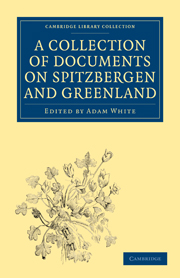 A Collection of Documents on Spitzbergen and Greenland
A Collection of Documents on Spitzbergen and Greenland Book contents
- Frontmatter
- INTRODUCTION
- PART THE FIRST VOYAGE INTO SPITZBERGEN AND GREENLAND
- PART THE SECOND CONTAINING THE DESCRIPTION OF SPITZBERGEN
- PART THE THIRD
- PART THE FOURTH OF THE ANIMALS OF SPITZBERGEN
- CHAP. I Of Birds with Toes or Divided Feet
- CHAP. II Of the Broad or Web-Footed Birds
- CHAP. III Of some other Birds that I did not Catch or Delineate
- CHAP. IV Of the Four-Footed Creatures
- CHAP. V Of the Crustaceous Fish that I Observed
- CHAPTER VI
- CHAPTER VII Of the Whale
- CHAP. VIII How they Catch the Whale
- CHAP. IX What they do with the Dead Whale
- CHAP. X Of the Trying out of the Train-Oyl from the Fat
- CHAPTER XI Of the Finn-Fish
- CHAP. XII Of Rotz-fishes and Sea-qualms
- LIST OF THE ANIMALS OF SPITZBERGEN
- DESCRIPTION OF GREENLAND
- INDEX
- Plate section
CHAP. II - Of the Broad or Web-Footed Birds
Published online by Cambridge University Press: 05 June 2011
- Frontmatter
- INTRODUCTION
- PART THE FIRST VOYAGE INTO SPITZBERGEN AND GREENLAND
- PART THE SECOND CONTAINING THE DESCRIPTION OF SPITZBERGEN
- PART THE THIRD
- PART THE FOURTH OF THE ANIMALS OF SPITZBERGEN
- CHAP. I Of Birds with Toes or Divided Feet
- CHAP. II Of the Broad or Web-Footed Birds
- CHAP. III Of some other Birds that I did not Catch or Delineate
- CHAP. IV Of the Four-Footed Creatures
- CHAP. V Of the Crustaceous Fish that I Observed
- CHAPTER VI
- CHAPTER VII Of the Whale
- CHAP. VIII How they Catch the Whale
- CHAP. IX What they do with the Dead Whale
- CHAP. X Of the Trying out of the Train-Oyl from the Fat
- CHAPTER XI Of the Finn-Fish
- CHAP. XII Of Rotz-fishes and Sea-qualms
- LIST OF THE ANIMALS OF SPITZBERGEN
- DESCRIPTION OF GREENLAND
- INDEX
- Plate section
Summary
There are several sorts of these about Spiizbergen. Some of them have thin pointed bills, others have thick and broad ones. Some of these thick-billed ones have them divided or parted, as the mallemucken (mad gnats in English); others have undivided one, as the parret so called.
There is also considerable difference in the heels of these birds, for some of them have heels, as the mountain-duck, kirmew, and mallemucks; others have them not at all, as the burgermeister, rathsher, strundjager, kutyegehf, parret, lumb, pigeon, and the red-goose; no water sticks to their feathers, no more than on the swans and other water-fowl, for it runs off from them as if they were oiled all over. Some are birds of prey, others not. There is also a difference in their flying. Some flie like unto a partridge, as that called the pigeon; others, like swallows, as the lumbs and red-geese; others, like the mews, as the mallemucke, rathsher, and strundjager; others, like the stork, as the burgermeister.
The birds of prey are, the burgermeister, rathsher, strundjager, kutyegehf, and mallemucke. There is also a great difference in their flesh; the birds of prey are not so good to eat as the others, except you hang them up by the legs for some days, that the train-oil may run out of them, and the air blow through them; and then you do not taste the train-oil so strong, for else it would make you vomit.
- Type
- Chapter
- Information
- A Collection of Documents on Spitzbergen and GreenlandComprising a Translation from F. Martens' Voyage to Spitzbergen, a Translation from Isaac de La Peyrère's Histoire du Groenland, and God's Power and Providence in the Preservation of Eight Men, pp. 60 - 78Publisher: Cambridge University PressPrint publication year: 2010First published in: 1855
